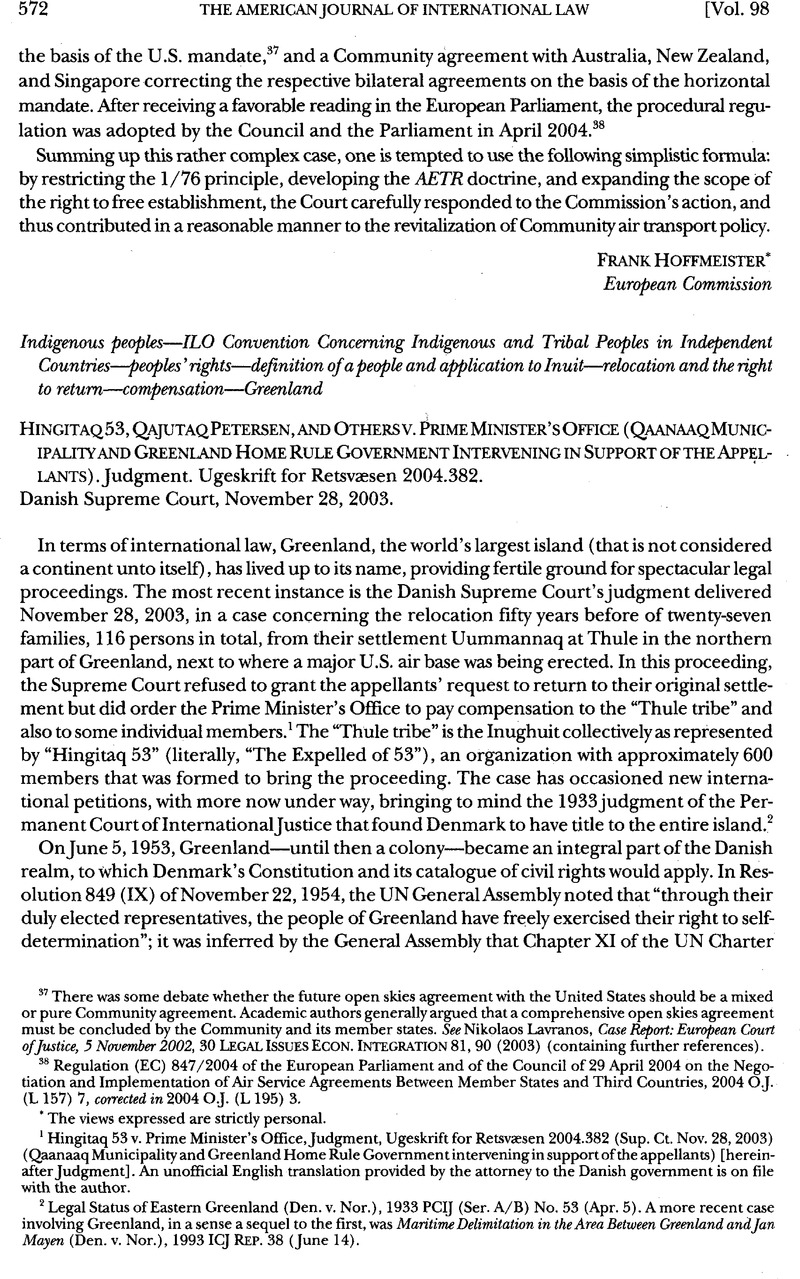Article contents
Hingitaq 53, Qajutaq Petersen, and Others v. Prime Minister's Office (Qaanaaq Municipality and Greenland Home Rule Government Intervening in Support of the Appellants)
Published online by Cambridge University Press: 27 February 2017
Abstract

- Type
- International Decisions
- Information
- Copyright
- Copyright © American Society of International Law 2004
References
1 Hingitaq 53 v. Prime Minister’s Office, Judgment, Ugeskrift for Retsvaesen 2004.382 (Sup. Ct. Nov. 28, 2003) (Qaanaaq Municipality and Greenland Home Rule Government intervening in support of the appellants) [hereinafter Judgment]. An unofficial English translation provided by the attorney to the Danish government is on file with the author.
2 Legal Status of Eastern Greenland (Den. v. Nor.), 1933 PCIJ (Ser. A/B) No. 53 (Apr. 5). A more recent case involving Greenland, in a sense a sequel to the first, was Maritime Delimitation in the Area Between Greenland and Jan Mayen (Den. v. Nor.), 1993 ICJ Rep. 38 (June 14).
3 ILO Convention (No. 169) Concerning Indigenous and Tribal Peoples in Independent Countries, June 27, 1989, 28 ILM 1382, at <http://www.ilo.org>.
4 See Briggs, Herbert W., Validity of the Greenland Agreement, 35 AJIL 506, 513 (1941)Google Scholar.
5 Agreement Concerning the Defense of Greenland, U.S.-Den., Apr. 27, 1951, 2 UST 1485, 94 UNTS 35.
6 There are currently just over six Danish kroner to the U.S. dollar.
7 Hingitaq 53 v. Prime Minister’s Office, Judgment, Ugeskrift for Retsvaesen 2004.382 (High Ct. Aug. 20, 1999) (Qaanaaq Municipality intervening in support of the claimants).
8 Id. at 594 (as translated by author).
9 See Danish Prime Minister’s Second Department, Report on Greenland 1952, at 53–54 (1952)Google Scholar; Danish Prime Minister’s Second Department, Report on Greenland 1954, at 56–57 (1954)Google Scholar. The reports were provided pursuant to Article 73(e) of the UN Charter.
10 Judgment, supra note 1, at 19–20.
11 Id. at 22–23.
12 See Meijknecht, Anna, Towards International Personality: The Position of Minorities and Indigenous Peoples in International Law 149–52, 168–69, 223 (2001)Google Scholar.
13 Report of the Committee Set Up to Examine the Representation Alleging Non-observance by Denmark of the Indigenous and Tribal Peoples Convention, 1989 (No. 169), Made Under Article 24 of the ILO Constitution by the Sulinermik Inuussutissarsiuteqartut Kattuffiat (SIK), ILO Governing Body, 280th Sess., Agenda Item 18, para. 33, ILO Doc. GB.280/18/5 (2001). In the Supreme Courtjudgment’s translation of this passage (into Danish), the last word is folk, meaning “peoples,” as opposed to groups, which is used in the original English.
14 ILO Convention (No. 107) Concerning the Protection and Integration of Indigenous and Other Tribal and Semi-tribal Populations in Independent Countries, June 26, 1957, 328 UNTS 247.
15 See, e.g., Tomei, Manuela & Swepston, Lee, Indigenous and Tribal Peoples: A Guide to ILO Convention No. l69, at 11, 15–22 (1996)Google Scholar; James Anaya, S., Indigenous Peoples in International Law 48 (1996)Google Scholar; Thornberry, Patrick, Indigenous Peoples and Human Rights 345–47, 366–67 (2002)Google Scholar.
16 Memorandum of Understanding Concerning the Dundas Area, U.S.-Den. (incl. Home Rule Gov. Green.), Feb. 20, 2003, at <http://www.usembassy.dk/Policy/IssuesInFocus/MissileDefense/DundasMemorandum.htm>.
17 Committee on Elimination of Racial Discrimination, Concluding Observations: Denmark, para. 18, UN Doc. CERD/C/60/CO/5 (2002). Article 1 (1) of the International Convention on the Elimination of All Forms of Racial Discrimination, Mar. 7, 1966, 660 UNTS195, states that the Convention applies to “any distinction, exclusion, restriction or preference based on race, colour, descent, or national or ethnic origin which has the purpose or effect of nullifying or impairing the recognition, enjoyment or exercise, on an equal footing, of human rights and fundamental freedoms in the political, economic, social, cultural or any other field of public life.”
18 See in this respect Partial Revision of the Indigenous and Tribal Populations Convention, 1957 (No. 107), International Labour Conference, 75th Sess., Report VI(2), at 16 (1988), and also Benedict Kingsbury, “Indigenous Peoples” in International Law: A Constructivist Approach to the Asian Controversy, 92 AJIL 414, 420–21, 440, 453–55 (1998).
- 2
- Cited by




